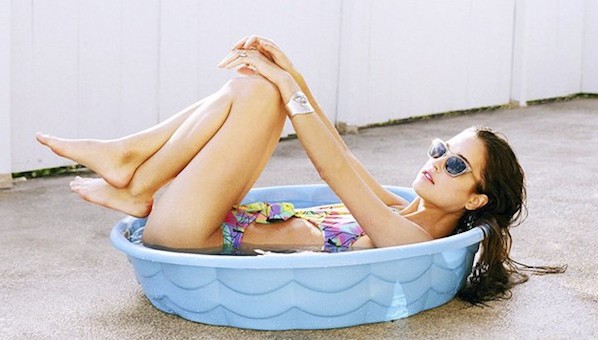One of the reasons we pay a premium to live in Southern California is because of the even-keeled, perpetually sunny weather. So few things annoy SoCalers more than a deviation from that. A little drizzle almost always causes city-wide traffic paralysis in LA, and a heat wave sends folks swarming to coastal cities and the beach (also causing freeway back-ups). (Thank goodness it doesn’t snow in the city). But this year, not even coastal cities were spared from the recent heat wave we’ve had here in SoCal. With days reaching into three-digit highs, and humidity indexes comparable to that of summers in Asia, there were days when I didn’t think even our central AC unit could keep the house cool.
I know, I know. Heat waves aren’t a unique phenomenon by any means. There are many states across the US, and countries worldwide, that deal with (more) severe weather extremes on a constant basis. But this is LA, and we Angelenos are spoiled-rotten, weather divas. We don’t like change — especially not a departure from our usual happy, sunny weather. When temps dip under 65, we bring out our OTK boots, scarves, and peacoats, and when the temps cross over 85, we whine and complain.
I’m thankful that we have central AC. I know many people that don’t have an AC unit, and can’t afford to buy a portable one. I can’t even begin to feel their pain. So unless you’re a big fan of free sauna, here are some ways to stay cool during a heat wave.
1. Stay hydrated. When it’s hot, we perspire more so it’s important to replenish what we lose in sweat with lots of fluids, preferably just good ol’ H2O. (Here’s why). Avoid caffeinated drinks and especially alcohol because they tend to dehydrate.
2. Maintain constant air circulation. When it’s hot, it’s important to keep air flowing so that the hot air moves around and cycles out. Keep the windows open and use fans. Speaking of fans…
3. Fans, fans, fans. Not only do they help maintain air circulation, the breeze can offer a welcome reprieve in a hot room. Place a large bowl of ice in front of a fan and you have yourself a DIY cooling system. It certainly doesn’t replace an AC, but at least it’ll produce some cool air.
4. Seek shade when outdoors. Direct sun exposure raises body temperature — not to mention that the heat index is higher when you’re standing in direct sun. So it’s important to avoid the sun if you’re looking to stay cool.
5. Go to a indoor, public place that offers AC. Public establishments such a coffee shops, libraries, grocery stores, and malls always have the AC running so peruse the mall on a hot day, kill two birds with one stone and get your grocery shopping done while cooling off, or stop by your local library and seek relief among the stacks.
6. Wear loose-fitting, lightweight clothes. Few things feel worse than clammy clothes sticking to your sweaty body on a hot and humid day. Lightweight fabrics, like linen, tend to breathe better and can help you feel cooler than 100% cotton fabrics. And here’s a tip for color palettes during sun-filled days: Wear black clothing. Sure, it sounds like it goes against popular wisdom, because black absorbs energy and white reflects it. But white will reflect the sun’s energy back AND will reflect the energy your own heat-producing body gives off back to your body. Black will absorb both, but with even a hint of wind, the accumulated energy will be dispersed much more efficiently than if you wear wearing white. They key? Finding loose-fitting black clothing in lightweight materials, like your usual light-colored summer clothing. No wind? Stick to white.
7. Cool showers. Nothing says cool down like a cold shower. It really is the best, and surefire, way to cool down.
8. Light meals. Heavy, hot, high-calorie meals require more metabolism to digest, thereby raising your body’s temperature. Stick to “light” foods such as salads, fruit, cold sandwiches, and chilled soups.
9. Close the shades/curtains if direct sunlight is hitting your windows. By blocking out the sun’s rays, you can help lower a room’s temperature.
10. Avoid heading outdoors between 11am and 3pm. These are usually the hottest times of a day. If you must, seek shade, and if possible, wear a wide brimmed hat to keep your head and face shielded from the sun.
11. Ice packs. If you’re impatient, and want immediate relief, you can always put some ice packs on the insides of your wrists, as well as the back of your neck. These spots contain pulse points (basically where blood vessels are very close to the surface of the skin) so by cooling these areas down, you’re cooling down your blood and bringing down your overall body temperature.
It’s important to recognize signs of heat exhaustion and dehydration – especially during a heat wave – and seek treatment as quickly as possible. If left untreated, heat exhaustion can lead to the much more dangerous heat stroke, which can cause brain damage, and even death. If you feel any combo of the below symptoms (sourced from WebMD.com), seek shelter and cool off immediately.
- Confusion
- Dark-colored urine (a sign of dehydration)
- Dizziness
- Fainting
- Fatigue
- Headache
- Muscle cramps
- Nausea
- Pale skin
- Profuse sweating
- Rapid heartbeat
Stay cool, people.
For more more information on heat exhaustion and dehydration, check out this article, and this one.


















